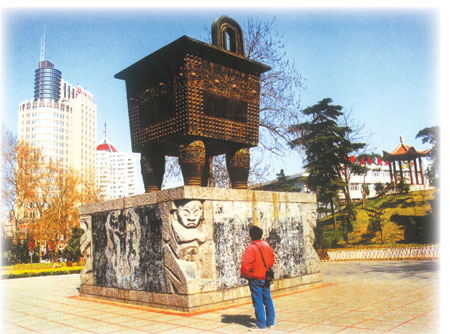Back to the future for revival of past glory
 |
| A corner of Shangcheng Road in Zhengzhou, capital of Henan Province.Ying Fu |
It is a question that has been puzzling Liu Zhanguo, a scholar with the Henan Development Research Center.
The traditional way of describing Henan Province is by its strategic location: In the heart of the country, where the major roads going north-south and east-west intersect.
The old saying, "Once you rule the Central Plains, you rule everywhere under heaven" is often repeated in connection with Henan, even though it does not strictly correspond to the present-day administrative demarcation.
Pressed further for a simple phrase summing up the province, Liu observed: "Henan is to China what China is to the world".
The analogy was not his invention, he said. It is shared by many academics and government officials. He elaborated further:
Henan is the most populous province in the nation, with close to 100 million people. It has the largest rural population, with 70 million. It has the longest traceable history of civilization, going back 8,000 years.
For some 2,000 years and 20 dynasties, one of its cities served as the seat of central government. In fact, four of China's eight "ancient capital cities" were in Henan.
Kaifeng, for instance, was a city built 2,700 years ago. In its heyday some 700 years ago it had a population of 1.5 million and was arguably the biggest city in the whole world. Now, after three decades of hectic growth, the urban population is still half that number.
Xinzheng, a suburban town south of Zhengzhou, was a city state for more than 500 years before the brutal Emperor Qin unified China. Now it is just the place where a far-flung airport happens to be located.
During the last two feudal dynasties that spanned 544 years, Henan has become increasingly irrelevant as the nation shifted its political and economic focus elsewhere.
In the past decade, however, Henan has been back in the news, but for all the wrong reasons, like its AIDS village and stories reinforcing negative stereotypes about the Henanese.
Is the province as grim as some paint it to be? Or is it just that the phoenix is once more rising from the ashes? The resilience of Henan people is surprising.
Despite the burdens of a large rural population, unskilled surplus labor, growing income disparities, a shortage of social services and pollution, the province is ridding itself of the shackles of the old days and meeting new challenges head-on.
One of the challenges is to develop modern industries while keeping its advantage as a production base for agricultural products. Out of every 10 steamed buns, 4.5 are made of wheat grown in Henan, Li Zhengxin, a researcher with a government think tank, said.
In recent years, the province has been leveraging its agricultural muscle by building a food processing industry.
"A significant proportion of the packaged food sold nationwide, including some of the major brands, are produced here," Li said.
"Ningbo rice-flour dumplings, both the rice and the fillings, are Henan-made, and the whole production chain is here. It's not the content but only the label that says this is from the coastal city in Zhejiang Province."
In addition to being the number one province in terms of meat processing, Henan has the overall industrial strength that lags behind only a few coastal provinces. However, it needs to push ahead with industrialization so that income can keep rising. Urbanization is another issue, as more of its 35 million surplus farmers take service-sector jobs.
Much discrimination against Henanese derives from the surplus population of 6-7 million that migrates to other provinces in search of a better life. In the fierce competition for opportunities, clashes are bound to happen and unfavorable impressions sometimes linger, think-tank researcher Li said.
To counteract the negative image, Henanese are turning to the past for inspiration.
"Thick" and "heavy" are two words often used to describe the province, referring to the culture and the ancient artifacts that have been unearthed in its soil.
Some experts, however, argue that it is better not to find comfort in the past but to look forward and create something new, something like the Zhengzhou Eastern District.
They call it "the rise of the Central Plains".
Does it ring a bell?
(China Daily 10/19/2007 page25)














